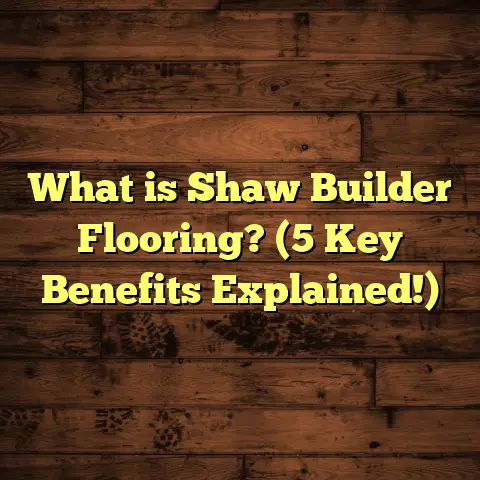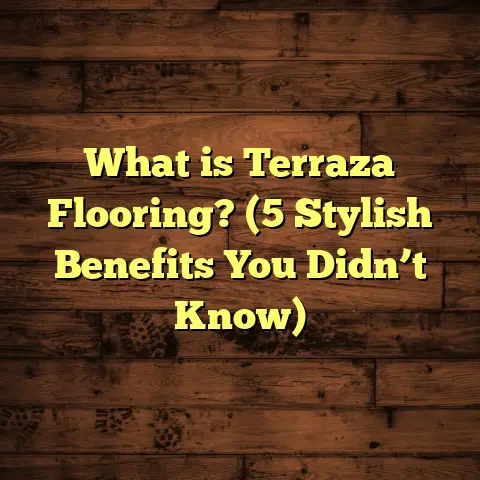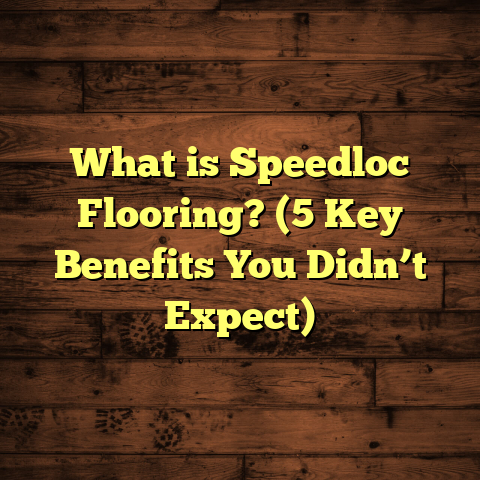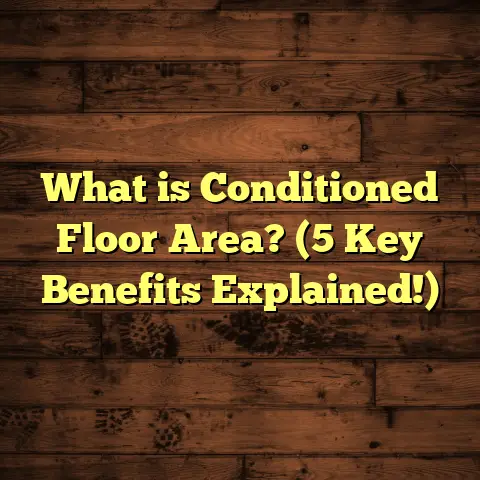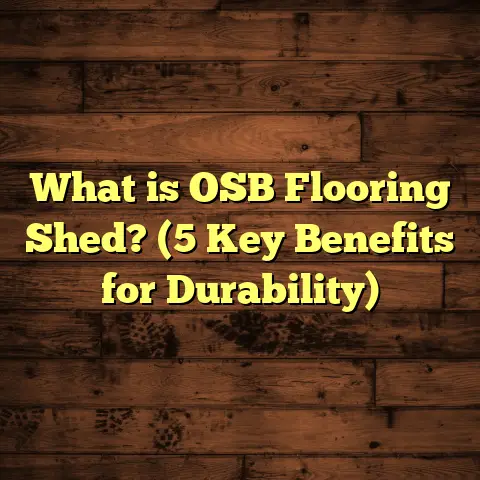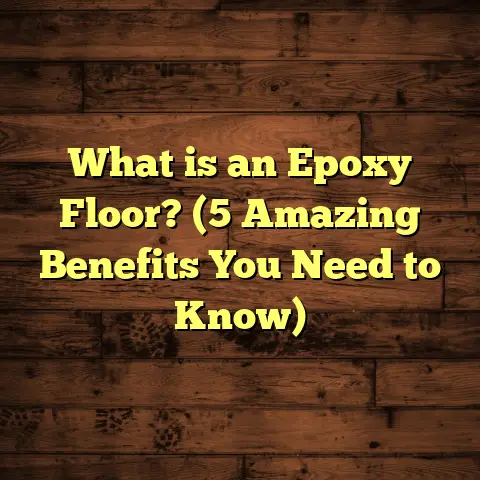What is Hybrid Vinyl Flooring? (5 Key Benefits You Need)
What is Hybrid Vinyl Flooring?
Have you ever wondered why some floors look stunning yet seem impossible to damage? Or why certain flooring options promise durability but fall short when faced with everyday life? I remember when hybrid vinyl flooring first came onto my radar. At first, I thought it was just another marketing buzzword, but after using it on several projects, I realized it’s something different.
Hybrid vinyl flooring is a modern flooring solution that combines the advantages of luxury vinyl flooring (LVP) with rigid core materials like SPC (Stone Plastic Composite) or WPC (Wood Plastic Composite). The goal? To create a floor that looks beautiful, feels comfortable, and handles moisture and wear better than many traditional flooring types.
Here’s what the structure typically looks like:
- Wear Layer: This is the topmost protective surface layer that guards against scratches, scuffs, stains, and general wear and tear. It usually ranges from 0.3 mm (12 mil) to 0.7 mm (28 mil). The thicker the wear layer, the longer the floor will last.
- Decorative Layer: Below the wear layer is the printed design layer. This is where manufacturers get creative, replicating everything from natural hardwood grains to intricate stone or ceramic tile patterns.
- Core Layer: The heart of hybrid vinyl is its core. SPC cores use a mix of limestone powder, PVC resin, and stabilizers, making them incredibly dense and rigid. WPC cores incorporate wood fibers with plastic to give more flexibility and warmth underfoot.
- Backing Layer: This supportive base layer adds stability and often includes soundproofing features.
When I installed hybrid vinyl in a beach house near Charleston, South Carolina, the homeowners were thrilled. The floors looked just like natural oak but had zero damage even after months of sandy feet, salt air humidity, and the occasional spill. In climates where humidity can wreak havoc on wood floors, hybrid vinyl holds its shape without warping or swelling.
5 Key Benefits You Need to Know
1. Water Resistance That Really Works
You might ask, “Why does water resistance matter so much?” From my experience in places like Florida and Louisiana — where the air is thick with humidity and flooding isn’t rare — water resistance is a game-changer.
Traditional hardwood floors soak up moisture, swell, and eventually buckle. Even engineered hardwood can struggle if water pools for long enough. Hybrid vinyl floors are built differently. The SPC or WPC core blocks water from penetrating, making it effectively waterproof.
Here’s a personal story: I worked on a townhouse in Miami where the family wanted hardwood aesthetics but also lived steps away from the ocean. After a hurricane caused minor flooding in their entryway, their hybrid vinyl floor remained undamaged while neighbors with hardwood were left replacing warped boards.
To put numbers on it: SPC hybrid vinyl floors have moisture absorption rates below 0.01%, compared to hardwood’s 8-12%. This means they stay stable even in wet conditions.
This water resistance makes hybrid vinyl ideal for:
- Bathrooms
- Kitchens
- Basements
- Laundry rooms
- Mudrooms
- Commercial spaces prone to spills or moisture
2. Durability That Stands Up to Life
Durability is not just about resistance to scratches — it’s about handling everything life throws at your floors without showing it.
The wear layer on hybrid vinyl typically ranges between 20 mils (0.5 mm) to 28 mils (0.7 mm). This thickness protects against daily foot traffic, pet claws, furniture movement, and even kids’ toy cars.
I remember installing hybrid vinyl in a daycare center in Dallas. The director was skeptical initially but was amazed when the floors showed only minor scuffs after two years of heavy use by toddlers running and playing all day.
Industry data supports this: Floors with wear layers above 20 mils can last 15-20 years with proper care. For comparison:
- Hardwood floors can dent or scratch easily from dropped objects.
- Laminate floors have thinner wear layers and can chip or peel over time.
- Carpet wears unevenly and stains permanently.
Hybrid vinyl combines scratch resistance with impact resistance thanks to its rigid core. That means less worry about dents or cracks.
3. Easy Installation Saves Time and Money
One of my favorite parts about hybrid vinyl flooring is how fast and straightforward it is to install.
Many products come with a click-lock system — planks snap together without glue or nails. This floating installation means you don’t have to mess with messy adhesives or nails that damage subfloors.
I once helped a DIY client install 700 square feet of hybrid vinyl flooring over a weekend. With two people working, they finished in just two days — far faster than the five days they initially expected for hardwood installation.
Here’s an average timeline comparison:
| Flooring Type | Installation Time (1000 sq ft) |
|---|---|
| Hybrid Vinyl | 1-2 days |
| Hardwood | 4-7 days |
| Tile | 5-10 days |
| Laminate | 2-3 days |
Labor costs also vary accordingly. For hybrid vinyl:
- Material costs: $3 – $7 per sq ft
- Labor costs: $2 – $4 per sq ft (depending on location)
This means total project costs for a 1,000 sq ft room typically fall between $5,000 and $11,000.
Because you can install hybrid vinyl over many subfloor types — concrete slabs, plywood, existing vinyl floors — you save additional prep time and money too.
4. Realistic Designs That Impress Visitors
Years ago, vinyl flooring had a reputation for looking cheap or fake. That changed dramatically with hybrid vinyl.
The printing technology now uses high-resolution digital imaging combined with embossing techniques that replicate wood grain texture or stone surfaces. I’ve installed floors that look so real visitors often ask if they’re hardwood or natural stone.
Some popular designs include:
- Reclaimed oak with knots and grain variation
- Weathered gray barnwood looks
- Polished marble tile patterns
- Slate stone textures with realistic shading
I once worked on a restaurant renovation in Chicago that wanted natural stone aesthetics but couldn’t afford heavy tile installation. Hybrid vinyl delivered the look without the weight or cost — plus it was easier to clean after busy nights.
5. Comfort and Sound Underfoot
Another benefit many people overlook is how comfortable hybrid vinyl feels compared to tile or laminate.
The core layers provide some springiness underfoot — especially WPC cores that include wood fibers — making standing or walking easier on joints.
Many hybrid vinyl planks come with pre-attached underlayment made of cork or foam for added cushioning and noise reduction.
In apartment buildings where noise complaints are common, this sound absorption helps reduce footsteps and echoes between units.
When I installed hybrid vinyl in a newly built condo complex in Seattle, tenants reported noticeably quieter floors compared to neighboring buildings with tile or laminate.
Understanding Core Types: SPC vs WPC
Hybrid vinyl flooring cores make a big difference in performance and feel:
Stone Plastic Composite (SPC)
SPC cores are made by mixing limestone powder with PVC plastic and stabilizers under heat and pressure. The result is an extremely dense, rigid core less than 5 mm thick but very resistant to dents and impacts.
SPC hybrid vinyl is ideal for:
- High traffic areas
- Commercial spaces
- Wet environments like bathrooms or basements
It feels firm underfoot but may be colder compared to WPC.
Wood Plastic Composite (WPC)
WPC cores combine wood fibers with plastic composites to create a thicker core ranging from 5 mm to 8 mm thick. This core offers more softness and warmth underfoot than SPC but sacrifices some rigidity.
WPC hybrid vinyl works well in:
- Residential living rooms
- Bedrooms
- Areas where comfort matters as much as durability
It also tends to have better sound insulation properties due to its thickness.
Maintenance Tips from My Experience
Maintaining hybrid vinyl flooring is simple but doing it right extends your floor’s life significantly.
Here are my top tips:
- Regular Sweeping or Vacuuming: Dirt and grit can scratch any surface over time.
- Damp Mopping: Use a microfiber mop with warm water or manufacturer-recommended cleaners.
- Avoid Harsh Chemicals: Steer clear of abrasive cleaners or wax-based products.
- Protective Pads: Put felt pads under furniture legs to prevent dents.
- Clean Spills Quickly: Even though it’s waterproof, standing liquids shouldn’t be left too long.
- Avoid Dragging Heavy Objects: Lift items rather than dragging to avoid gouges.
- Sunlight Protection: Use blinds or curtains to prevent fading in direct sunlight areas.
A client of mine in New Jersey who neglected these tips saw their floor dull prematurely within two years. After switching to proper care routines, their new hybrid vinyl floor stayed vibrant for over five years with minimal wear.
Cost Breakdown: What You Should Expect
Understanding cost helps manage expectations and plan your budget better.
Here’s an average breakdown based on recent projects I’ve worked on across different regions:
| Cost Element | Range per sq ft | Notes |
|---|---|---|
| Material | $3 – $7 | Depends on wear layer thickness & design |
| Labor | $2 – $4 | Varies by region & complexity |
| Subfloor Preparation | $0 – $2 | Removal of old floor or leveling |
| Underlayment | Included or $0.50-$1 | Some planks have attached underlayment |
| Removal Fees | $1 – $3 | If replacing old floors |
For example:
Project: 1,000 sq ft residential kitchen & living room
- Materials: $5 per sq ft = $5,000
- Labor: $3 per sq ft = $3,000
- Subfloor prep: $1 per sq ft = $1,000
- Total estimated cost = $9,000
Prices vary widely based on location; urban areas like New York or San Francisco tend to be at the higher end due to labor costs.
Installation Insights & Common Challenges
Even though installation is easier than many flooring types, there are some things I always remind clients or installers about:
Acclimation Period
Hybrid vinyl needs time to adjust to room temperature and humidity before installation — typically 48 hours inside the house in unopened boxes.
Skipping this can cause expansion or contraction issues later.
Subfloor Condition
Floors must be level within 3/16 inch over 10 feet. Uneven subfloors lead to plank shifting or damage.
Concrete slabs should be dry (<4% moisture content) and clean of debris.
Expansion Gaps
Since hybrid vinyl floats over subfloors, installers need to leave expansion gaps around walls (typically 1/4 inch) to allow movement without buckling.
Cutting & Layout
Cutting planks requires sharp utility knives; clean cuts ensure tight seams.
Planning layout carefully reduces waste; staggering seams by at least 6 inches creates natural patterns and stability.
How Hybrid Vinyl Flooring Fits Different Budgets
One thing I love about hybrid vinyl is its versatility for various budgets:
- Entry-Level Options: Basic designs with thinner wear layers ($3-$4/sq ft) suitable for low traffic areas.
- Mid-Tier Products: Popular wear layers around 20 mils with realistic textures ($4-$6/sq ft).
- Premium Lines: Thickest wear layers (28 mils+), enhanced soundproofing, luxury designs ($6-$8/sq ft).
You can choose based on your lifestyle needs:
- Families with kids/pets may want premium for durability.
- Renters might pick entry-level since floors are affordable and replaceable.
- Commercial spaces benefit from mid-to-premium for heavy traffic resistance.
Comparing Hybrid Vinyl with Other Popular Flooring Choices
To understand what makes hybrid vinyl so unique, here’s how it stacks up against other common options:
Hardwood Flooring
| Feature | Hardwood | Hybrid Vinyl |
|---|---|---|
| Appearance | Natural beauty & authenticity | Very realistic printed designs |
| Water Resistance | Poor | Excellent |
| Durability | Prone to dents & scratches | High scratch & impact resistance |
| Cost | $6 – $15+ per sq ft | $3 – $7 per sq ft |
| Maintenance | Requires refinishing | Easy cleaning |
Laminate Flooring
| Feature | Laminate | Hybrid Vinyl |
|---|---|---|
| Appearance | Printed wood look | Textured & more realistic |
| Water Resistance | Poor/Moderate | Waterproof |
| Durability | Susceptible to swelling | Rigid core resists damage |
| Cost | $1 – $4 per sq ft | $3 – $7 per sq ft |
| Installation | Floating click-lock | Floating click-lock |
Tile Flooring
| Feature | Tile | Hybrid Vinyl |
|---|---|---|
| Appearance | Natural stone/glass look | Stone/ceramic printed look |
| Water Resistance | Excellent | Excellent |
| Comfort | Cold/hard | Soft/comfortable |
| Installation | Complex/Time-consuming | Quick/Easy |
| Cost | $5 – $15+ per sq ft | $3 – $7 per sq ft |
Real-Life Case Studies from My Projects
Case Study #1: Renovating a Historic Home in Boston
The owners wanted an authentic hardwood look but had concerns about basement moisture causing damage.
Solution: Installed SPC-based hybrid vinyl throughout first floor and basement entryway.
Result: After 18 months of use through harsh winters and rainy springs, no signs of damage or warping.
Case Study #2: Commercial Office Space in Denver
The company needed durable floors that could handle heavy foot traffic from employees and clients without constant repair costs.
Solution: Mid-grade SPC hybrid vinyl with thick wear layer installed over concrete slab with soundproof underlayment.
Result: Floors remain pristine after two years; employees commented on reduced noise levels from footsteps compared to carpet previously installed.
Case Study #3: Family Home in Austin
A family with two young children and two dogs wanted floors that were easy to clean but looked warm and inviting like wood floors.
Solution: WPC core hybrid vinyl installed throughout main living spaces including kitchen and playroom.
Result: Kids’ spills wiped up easily; scratches from dog nails minimal; family pleased with comfort underfoot during playtime sessions.
Future Trends in Hybrid Vinyl Flooring
With growing demand for waterproof and durable flooring solutions, manufacturers continue innovating:
- Eco-Friendly Materials: More brands are using recycled content in cores and wear layers.
- Improved Textures: Laser embossing technology creates even more realistic surfaces.
- Wider Planks & Tiles: Larger formats mimic upscale hardwood boards or stone slabs.
- Smart Floors: Integration of antimicrobial coatings or anti-static properties.
- Enhanced Underlayments: For superior soundproofing in multi-story buildings.
I’m excited about these developments because they mean better options for every home or business budget while maintaining quality standards I’ve come to expect from hybrid vinyl products.
FAQs Based on My Experience
Q: Can hybrid vinyl flooring go over radiant heating?
A: Yes! Most hybrid vinyl products are compatible with radiant heat systems as long as surface temperatures don’t exceed manufacturer limits (usually around 85°F).
Q: How do I repair damaged planks?
A: Minor scratches can sometimes be buffed out; otherwise you can replace individual planks thanks to the floating installation system without tearing up the whole floor.
Q: Is hybrid vinyl safe for allergy sufferers?
A: Yes! It doesn’t trap dust mites or allergens like carpet does and is easy to keep clean which helps reduce indoor allergens.
Wrapping Up My Thoughts on Hybrid Vinyl Flooring
When you think about investing in new floors, you want something that balances beauty, durability, ease of maintenance, affordability, and comfort — all while fitting your lifestyle demands. Hybrid vinyl flooring ticks all those boxes better than most alternatives I’ve worked with over my career.
Whether you’re renovating a bathroom prone to moisture problems or outfitting a commercial space needing tough floors that last under heavy use, hybrid vinyl offers practical benefits without sacrificing style or feel.
If you want help figuring out if this is the right option for your project — including detailed cost estimates tailored to your home — feel free to ask me anytime!
If you want me to walk you through calculating your budget using tools like FloorTally or help pick specific products based on your needs and location climate — just say the word! I’m here every step of the way making flooring decisions easier for you.
